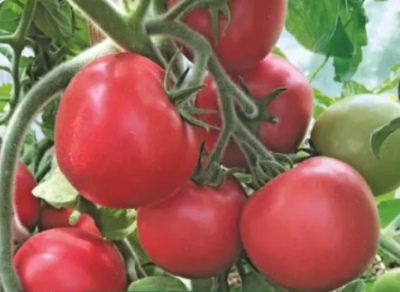
- Authors: IN AND. Blokin-Mechtalin
- Year of approval: 2019
- Category: hybrid
- Growth type: determinant
- Appointment: universal
- Ripening period: early
- Ripening time, days: 95-100
- Growing conditions: for film greenhouses, for greenhouses
- Bush height, cm: 80-90
- Bush characteristic: compact
Tomato Fuzzy Pink is one of the popular varieties that attract gardeners with high yields, strong immunity and excellent taste characteristics of the fruits. It is worth taking a closer look at the features of a tomato.
Description of the variety
Fluffy is suitable for planting in greenhouses. Description of the variety:
- compact bushes;
- prolonged fruiting;
- green leaves of medium length;
- inflorescences of 2 types: simple and semi-complex.
Small villi can be seen on the stems. The length of the leaves reaches 25 cm.
The main qualities of the fruit
Fruit characteristics:
- average weight - 120-150 g;
- shape - rounded;
- the skin is dense, glossy;
- pink colour.
Fruits of moderate juiciness have a fleshy pulp. The tomato has a universal purpose. The fruits are suitable for fresh consumption and conservation. Also tomatoes can be used for processing in purees or juices.
Taste characteristics
The first fruits are formed 3 months after transplanting the seedlings into the ground. The fruits are distinguished by a juicy pulp of a rich pink hue, have a sugar taste with a slight acidity, and a pleasant aroma.
Ripening and fruiting
Ripening of Fuzzy tomatoes occurs within 95-100 days from the moment the plants are planted in the ground. It is noteworthy that the fruits ripen sequentially, not all at once.
Yield
Fuzzy has a high yield. It is possible to collect up to 4 kg from one bush, 1 m 2 gives up to 12.7 kg of ripe fruits.
The timing of planting seedlings and planting in the ground
Seeds are planted in prepared containers in the first half of March, pre-fertilizing the soil. For the emergence of the first shoots, it is necessary to achieve a temperature under the film of 25 ° C. Remove the film after seed germination. When 3 true leaves have formed, the tomatoes can be transplanted into a larger container.

Growing tomato seedlings is an extremely important process, because it largely depends on whether the gardener will be able to harvest at all. All aspects must be taken into account, from seedbed preparation to planting in the ground.
Landing scheme
The seedlings are ready for planting in the greenhouse after the formation of 6–8 leaves. This result can be achieved within 2 months from the date of sowing. Before replanting young tomatoes, it is recommended to harden the plants for a week. To do this, the ready-made seedlings, first for a couple of hours, and then for a couple of days are taken out to the balcony or veranda, helping the plants to get used to new conditions.
Planting in a greenhouse provides for compliance with the density of placement of seedlings. Gardeners recommend planting it in such a way that there are 4 plants per square meter.

Growing and care
Tomato is formed into 3-4 stems. The fluffy is picky about care, so you should pay special attention to feeding and watering.
- For the first time, top dressing is introduced 7 days after planting seedlings in the ground. For 20 sprouts there is 0.5 liters of mullein or chicken droppings infusion diluted in 10 liters of water. To prepare the solution, the organic material is placed in a container, and then poured with water and infused for 5 days. When applying fertilizer, it is necessary to avoid getting the solution on the leaves and stems, so as not to cause burns to the plant.
- The second feeding with the same solution is introduced after 2 weeks.
- The third stage of fertilization involves the use of a solution of 20 g of superphosphate and nitroammophoska. At this stage, loosening of the soil is also carried out.
Watering for a tomato is also very important. The first time it is watered immediately after planting. The next watering is started after 1-2 weeks, focusing on the climate and weather. Average consumption - 5 liters of water per 1 m 2. After flowering, it is recommended to organize watering in the amount of 10 liters per 1 m 2.




A plant needs different micronutrients at each stage of growth. All fertilizers can be divided into two groups: mineral and organic. Folk remedies are often used: iodine, yeast, bird droppings, eggshells.
It is important to observe the rate and period of feeding. This also applies to folk remedies and organic fertilizers.
Disease and pest resistance
Tomato Fuzzy Pink has strong immunity. The plant is not attacked by sucking insects, which cannot get close to the fruit due to the pubescent stems. However, high immunity does not protect:
- from a lack of nitrogen, which leads to yellowing of the leaves;
- lack of calcium, causing a red or purple tint of the leaves;
- from lack of magnesium.
Over-watering is highly likely to develop top rot, which is difficult to get rid of. If a disease is detected, it is recommended to carry out foliar feeding with a solution of calcium nitrate. It is best not to do anything with rotten fruits, which will recover over time or become an additional source of calcium. To avoid the development of unwanted diseases, it is recommended:
- follow the planting scheme, watering and feeding rules;
- prepare the soil by pre-disinfecting the area and adding the necessary fertilizers;
- regularly loosen the soil and huddle the plants.
Timely spraying of fruits with special means will be a prophylaxis against pests.



























































































